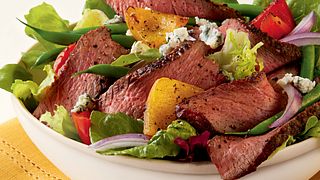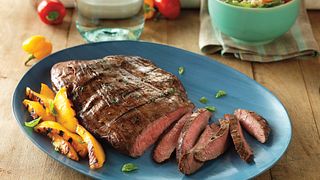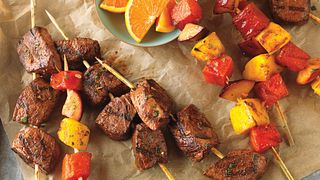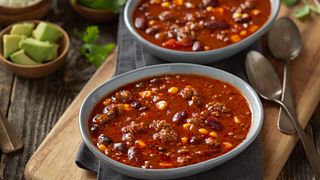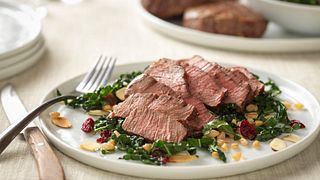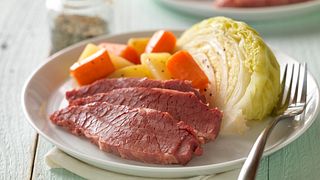Eat like the elite: Athletes know beef-rich diets can spur good health
July 22, 2021
Most Americans know firsthand how delicious beef can taste in salads, appetizers, and entrees. But many are less aware of how a diet rich in the savory red meat promotes strength and overall good health.
That fact is well-understood by our country’s elite athletes, who continually fine-tune their diets to maximize their performance in international competition. As our top athletes prepare to compete for gold this summer, a registered dietitian has tips for how you can eat like a champion at home.
“Simply put, beef is a protein powerhouse, especially when compared to some of the most popular plant-based protein options,” notes Dr. Shalene McNeill, Registered Dietitian and Executive Director of Nutrition Science, Health & Wellness at the National Cattlemen's Beef Association, a contractor to the Beef Checkoff. “You’d need to eat three cups of quinoa or 6.5 tablespoons of peanut butter to get the same amount of protein as three ounces of cooked beef — and that would mean consuming more than three times as many calories.”
Though multiple myths exist about beef production and consumption, the truth is that incorporating the protein-packed taste treat into your diet can benefit your health while supporting an industry that’s sound, sustainable into the future and of key importance to a wide segment of the world population.
In that spirit, here are six other facts about beef that may surprise you.
1. A unique mix of nutrients
By providing high-quality protein and multiple other essential nutrients (iron, zinc, potassium, phosphorus, niacin, vitamin B12 and vitamin B6), beef wards off deficiencies in those elements. No other protein source offers that unique and important mix of benefits.1,2
2. Big bang for the buck
Beef is an excellent food choice for those watching their weight, as 3 ounces pack approximately 25 grams of mind- and body-building protein into just about 170 calories. Overall, beef contributes only 5% of the calories found in the diet of the typical American. And it’s versatile enough to be enjoyed in a variety of breakfast, lunch and dinner dishes (as well as snacks).1-6
3. Beneficial for all ages
In young children, beef provides the protein, iron, zinc and B vitamins that help build growing bodies and brains. For those over age 50, the protein in beef helps prevent the loss of muscle mass that can lead to frailty and/or falls as people age.7-12
4. Lean cuts are good for your heart
Lean beef helps support cardiovascular health; happily, nearly 40 cuts of beef (including the ultra-popular sirloin) are classified as lean by the USDA.1, 13-16
5. Plant protein is not the same
Real beef contains an optimal mix of the amino acids needed to build and repair muscle; the body can’t produce amino acids on its own, and plant proteins provide a lesser variety. Real beef is also rich in the iron that helps prevent fatigue, and that iron is more easily absorbed from meat sources than from plant sources. Iron deficiency is already a global public health concern among women and adolescent girls.1, 15, 17-20
6. Beef cattle are raised sustainably
Contrary to popular belief, they’re a sustainable part of the food chain, playing the key role of converting inedible plants and solar energy into high-quality protein that’s helping to feed our growing global population. Not only do grain-finished beef operations in the U.S. generate 19% more protein for the human food supply than they consume, but they produce only 2% of all U.S. greenhouse gas emissions and sustain a carbon footprint that’s 10 to 50 times lower than other world regions.21-24
Follow the lead of our nation's champions and support your strength and energy by building the power punch of beef into your daily diet. Your body and your taste buds will thank you.
- US Department of Agriculture, Agricultural Research Service, Nutrient Data Laboratory. USDA National Nutrient Database for Standard Reference, Legacy. Version Current: April 2018. Internet: /nea/bhnrc/nd
- Zanovec M, O'Neil CE, Keast DR, Fulgoni VL 3rd, Nicklas TA. Lean beef contributes significant amounts of key nutrients to the diets of US adults: National Health and Nutrition Examination Survey 1999-2004. Nutr Res. 2010 Jun;30(6):375-8
- Michaelsen KF & Greer FR. Protein needs early in life and long-term health. Am J Clin Nutr 2014;99:718S–22
- Benton D. The influence of dietary status on the cognitive performance of children. Mol Nutr Food Res 2010;54:457–7
- Bonci LJ. Eating for performance: bringing science to the training table. Clin Sports Med 2011;30:661-7
- American College of Sports Medicine, Academy of Nutrition and Dietetics, Dietitians of Canada. Nutrition and Athletic Performance. Med Sci Sports Exerc 2016;48:543-68
- American Academy of Pediatrics. Pediatric Nutrition Handbook. 7th ed. Elk Grove, IL: American Academy of Pediatrics, 201
- Tang M, Krebs NF. High protein intake from meat as complementary food increases growth but not adiposity in breastfed infants: a randomized trial. Am J Clin Nutr2014;100:1322-
- Nyaradi A, et al. The role of nutrition in children’s neurocognitive development, from pregnancy through childhood. Front Hum Neurosci 2013;7:9 Krebs NF, et al. Effects of different complementary feeding regimens on iron status and enteric microbiota in breastfed infants. J Pediatr 2013;163:416-2
- Wolfe, R. The underappreciated role of muscle in health and disease. Am J Clin Nutr 2006; 84:475-82
- Layman DK, et al. Dietary protein and exercise have additive effects on body composition during weight loss in adult women. J Nutr 2005;135:1903-10
- Symons TB, et al. Aging does not impair the anabolic response to a protein-rich meal. Am J Clin Nutr 2007;86:451-6
- Roussell MA, et al. Beef in an Optimal Lean Diet study: effects on lipids, lipoproteins, and apolipoproteins. Am J Clin Nutr. 2012 Jan;95(1):9-16
- Roussell MA, et al. Effects of a DASH-like diet containing lean beef on vascular health. J Hum Hypertens. 2014 Oct;28(10):600-
- Sayer RD, et al. Equivalent reductions in body weight during the Beef WISE Study: Beef’s Role in Weight Improvement, Satisfaction, and Energy. Obes Sci Pract 2017;3:298–31
- O’Connor LE, et al. A Mediterranean-style eating pattern with lean unprocessed red meat has cardiometabolic benefits for adults who are overweight/obese in a randomized crossover controlled feeding trial. Am J Clin Nutr. 2018 Jul 1;108(1):33-4
- Winter WE, et al. The molecular biology of human iron metabolism. Lab Med 2014;45:92-10
- Clark SF. Iron deficiency anemia. Nutr Clin Pract 2008;23:128-4
- Cook JD. Adaptation in iron metabolism. The American Journal of Clinical Nutrition1990;51(2):301-30
- Le CHH (2016) The Prevalence of Anemia and Moderate-Severe Anemia in the US Population (NHANES 2003-2012). PLoS ONE 11(11): e0166635
- National Academies of Sciences, Engineering, and Medicine. 2016. Nutrient Requirements of Beef Cattle: Eighth Revised Edition. Washington, DC: The National Academies Press. https://doi.org/10.17226/1901
- Council for Agricultural Science and Technology (CAST). 1999. Animal Agriculture and Global Food Supply. Task force report N. 135 July 1999, Department of Animal Science, University of California, Davis, CA, USA. Available at: https://www.cast-science.org/wp-content/uploads/1999/07/CASTR135Animal-Agriculture-and-Global-Food-Supply.pdf
- EPA. 2018. Inventory of U. S. Greenhouse Gas Emissions and Sinks: 1990-2016. U. S. Environmental Protection Agency, Washington, D. C
- U.N. Food and Agriculture Organization. FAOSTAT Database – Food and agricultural data. Available at: http://www.fao.org/faostat/en/#home (accessed August 17, 2017)
tailgating treasures
Kick off the season with crowd-pleasing, hunger-tackling favorites like sliders, quesadillas and chili.

beef and strength
The essential nutrients found in beef, like protein, iron, zinc and B vitamins, provide our bodies and minds with the fuel we need at all stages of life to be the strongest version of ourselves.
sizzlin' steaks
Whether it’s on the grill, in the oven or in a skillet, these savory, satisfying steak recipes are sure add sizzle to any plate.
grilling favorites
It's always time to fire up the grill and we’ve got just what you’re looking for. Whether you want a classic burger or a spice-rubbed steak with a side of grilled fruit, this collection won’t disappoint.
